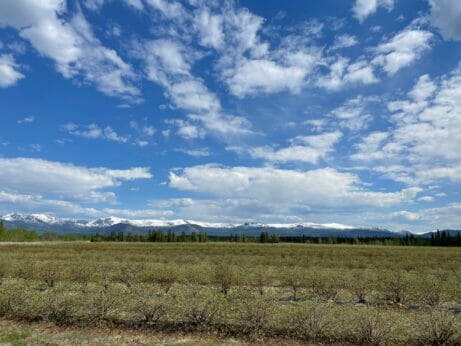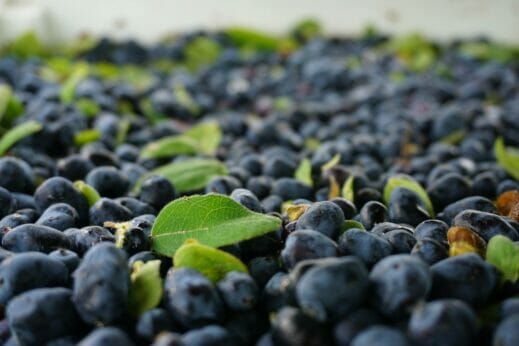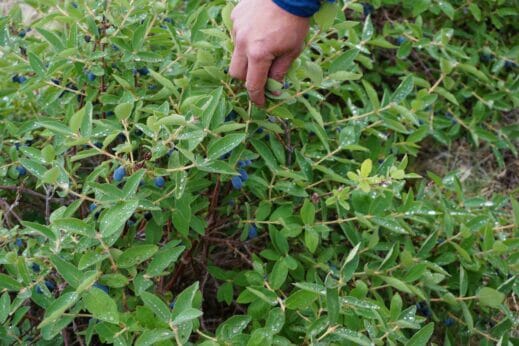How the Haskap Berry Survives Arctic Temperatures
Grown under the rays of the midnight sun, haskap berries are a rare agricultural export for Canada’s Yukon territory.
How the Haskap Berry Survives Arctic Temperatures
Grown under the rays of the midnight sun, haskap berries are a rare agricultural export for Canada’s Yukon territory.

Haskap berries grow in harsh conditions.courtesy of Yukon Berry Farms.
Agriculture is a tricky business in the Yukon. Bordering Alaska to the west, most of the landscape is tundra and northern boreal forest. Winters are long and very cold, with temperatures often dipping to below -40 degrees Celsius. Frosts can come as late as the end of May and return in mid-August. This makes the growing season short, a mere three months—if that. The main agricultural driver has traditionally been hay.
With only 88 farms producing just one percent of the fresh produce consumed locally, it’s not a choice but a necessity for food to be imported from the south. Until now. North of the capital Whitehorse, in the southernmost part of the territory, Yukon Berry Farms is growing 50,000 haskap berry plants on 50 acres.
In 2022, the farm yielded 15,000 pounds of berries, most of which will be turned into wine or cider and exported out of the territory—a rarity for the area, which is almost completely reliant on imported food.
It begs the question: How can haskaps be grown on such a massive scale, in such an inhospitable setting?

Haskaps, which look like an elongated blueberry and taste similar to a tart raspberry, grow wild in circumpolar regions throughout Canada, Asia and northern Europe. But very few people have heard of them.
“Wild haskaps are small and it takes a lot of picking to fill a bucket,” says Dr. Bob Bors, manager of the fruit program at the University of Saskatchewan. There, Bors has successfully hybridized more than 10 different varieties of haskaps, all suited for northern growing.
The idea of turning haskaps into a commercial crop first took seed in the 1950s. Canadian horticulturists hybridized a strain of haskap from wild plants and those commercially grown in Siberia. But it didn’t even make it to market. “That berry,” says Bors, “tasted like tonic water and fruit breeders saw no marketability in it.” Bors’ secret weapon was the sweet Japanese haskap, which he combined with the Canadian wild berry and Siberian cultivator to create a cold hardy plant, with a bigger, tastier fruit than earlier versions.
Now his berries are growing at Yukon Berry Farms. He’s not surprised at their success, especially with climate change causing warmer winters. In 2021, the lowest recorded temperature in Whitehorse was -45.5 degrees Celsuis. Further south in Abbotsford, the heart of British Columbia’s fertile berry-producing Fraser Valley, where mild winters are often the norm and spring comes early, the temperature barely dipped below -7 degrees Celsius.
“Haskaps love extended periods of deep, sub-zero cold,” says Bors. “In the south,they can wake up too earl, and flower before the bees and insects they rely on for pollination and ultimately fruit production have broken their hibernation.” Bors’ research also suggests that the heat typical of long southern summers could shut down the plant’s ability to grow and produce.
They’re also susceptible to humidity. “This can cause powdery mildew, a fungal disease, that damages the plant,” says Graham Gambles, secretary for the Haskap Berry Growers Association of Ontario. This makes Whitehorse’s dry climate (it receives less than 260 millimetres of rain, or 11 inches, annually) ideal for haskaps.

Kyle Marchuk, the co-owner of Yukon Berry Farms, knew how lucrative haskaps could be as an export crop from the moment he first encountered them.
“A friend of mine was growing haskaps on a small test plot, here in the Yukon, and they were producing more berries than on bushes being grown in the south. So many, in fact, that a buyer from outside of the Yukon was willing to buy all the berries that could be produced and export them out of the territory.”
It spurred Marchuk to become a partner in Yukon Berry Farms in 2014 and plant 20,000 haskaps. In 2016, at a food show in Tokyo, Japan, he showcased haskap berry jam and was amazed at the Japanese interest in the product. He knew then that haskaps could be a lucrative export market for Yukon growers.
By the end of 2018, Yukon Berry Farms had expanded operations and was growing more than 40,000 haskap bushes.

There are weeds that pop up between the plants and voles that eat the bark for food over the winter. “But the biggest challenge,” says Marchuk, “has been the changes the Canadian government made in 2019 to export licensing of fresh food.”
The Canadian Food Inspection Agency’s (CIFA) new regulations meant growers such as Marchuk would be required to do more paperwork and be subject to more inspections. The process was more time consuming than it had been and the licensing more expensive, so instead of exporting raw berries and jam, Marchuk and his partners opened Yukon’s first winery and cidery.
“The laws surrounding the export of alcohol are more lenient. We’re exporting haskap wine and cider to Japan and planning to get products into stores across Canada very soon,” he says.
Taking three to four years to reach maturity, each haskap bush can yield up to 10 pounds of berries a season—enough to share with the world and the local community, says Carl Burgess, executive director of the Yukon Agricultural Association. He sees no reason why haskap berries grown in the Yukon can’t be exported. “We have tomatoes from Mexico imported to the Yukon, so why not locally grown haskaps exported to Mexico?”
Follow us
This work is licensed under a Creative Commons Attribution-NoDerivatives 4.0 International License.
Want to republish a Modern Farmer story?
We are happy for Modern Farmer stories to be shared, and encourage you to republish our articles for your audience. When doing so, we ask that you follow these guidelines:
Please credit us and our writers
For the author byline, please use “Author Name, Modern Farmer.” At the top of our stories, if on the web, please include this text and link: “This story was originally published by Modern Farmer.”
Please make sure to include a link back to either our home page or the article URL.
At the bottom of the story, please include the following text:
“Modern Farmer is a nonprofit initiative dedicated to raising awareness and catalyzing action at the intersection of food, agriculture, and society. Read more at <link>Modern Farmer</link>.”
Use our widget
We’d like to be able to track our stories, so we ask that if you republish our content, you do so using our widget (located on the left hand side of the article). The HTML code has a built-in tracker that tells us the data and domain where the story was published, as well as view counts.
Check the image requirements
It’s your responsibility to confirm you're licensed to republish images in our articles. Some images, such as those from commercial providers, don't allow their images to be republished without permission or payment. Copyright terms are generally listed in the image caption and attribution. You are welcome to omit our images or substitute with your own. Charts and interactive graphics follow the same rules.
Don’t change too much. Or, ask us first.
Articles must be republished in their entirety. It’s okay to change references to time (“today” to “yesterday”) or location (“Iowa City, IA” to “here”). But please keep everything else the same.
If you feel strongly that a more material edit needs to be made, get in touch with us at [email protected]. We’re happy to discuss it with the original author, but we must have prior approval for changes before publication.
Special cases
Extracts. You may run the first few lines or paragraphs of the article and then say: “Read the full article at Modern Farmer” with a link back to the original article.
Quotes. You may quote authors provided you include a link back to the article URL.
Translations. These require writer approval. To inquire about translation of a Modern Farmer article, contact us at [email protected]
Signed consent / copyright release forms. These are not required, provided you are following these guidelines.
Print. Articles can be republished in print under these same rules, with the exception that you do not need to include the links.
Tag us
When sharing the story on social media, please tag us using the following: - Twitter (@ModFarm) - Facebook (@ModernFarmerMedia) - Instagram (@modfarm)
Use our content respectfully
Modern Farmer is a nonprofit and as such we share our content for free and in good faith in order to reach new audiences. Respectfully,
No selling ads against our stories. It’s okay to put our stories on pages with ads.
Don’t republish our material wholesale, or automatically; you need to select stories to be republished individually.
You have no rights to sell, license, syndicate, or otherwise represent yourself as the authorized owner of our material to any third parties. This means that you cannot actively publish or submit our work for syndication to third party platforms or apps like Apple News or Google News. We understand that publishers cannot fully control when certain third parties automatically summarize or crawl content from publishers’ own sites.
Keep in touch
We want to hear from you if you love Modern Farmer content, have a collaboration idea, or anything else to share. As a nonprofit outlet, we work in service of our community and are always open to comments, feedback, and ideas. Contact us at [email protected].by Jennifer Cole, Modern Farmer
July 19, 2023
Modern Farmer Weekly
Solutions Hub
Innovations, ideas and inspiration. Actionable solutions for a resilient food system.
ExploreExplore other topics
Share With Us
We want to hear from Modern Farmer readers who have thoughtful commentary, actionable solutions, or helpful ideas to share.
SubmitNecessary cookies are absolutely essential for the website to function properly. This category only includes cookies that ensures basic functionalities and security features of the website. These cookies do not store any personal information.
Any cookies that may not be particularly necessary for the website to function and are used specifically to collect user personal data via analytics, ads, other embedded contents are termed as non-necessary cookies.
My sister here in Winnipeg MB has a couple of bushes and man..talk about berries. The last couple of summers we’ve had high humidity and I’ve never seen any mildew on them.
Bumper crop on my u-pick berry farm at Mackenzie, BC. Will plant my 7th haskap variety this fall, about 60. I have 700 plants in the ground already.